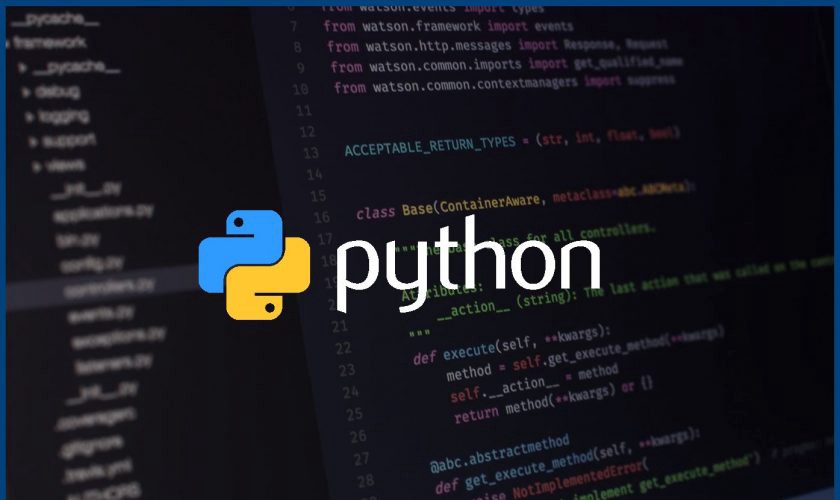Python String
A string is a sequence of characters. You must have used strings in other languages as well. Python strings play the same role as character arrays in languages like C, but they are somewhat higher-level tools than arrays.
Unlike languages such as C, in Python, strings come with a powerful set of processing tools.
Create a String
A python string is zero or more characters written inside single quotes ' ' or double quotes " "
S = 'Hello, World!' # single quotes
S = "Hello, World!" # double quotesMultiline Strings
You can create a multiline string using triple-quotes: """ """ or ''' '''.
S = """String literals can
span multiple lines."""
print(S)
# String literals can
# span multiple lines.The str() Constructor
You can convert almost any object in Python to a string using a type constructor called str()
# an integer to a string
S = str(42)
print(S)
# Prints '42'
# a complex number to a string
S = str(3+4j)
print(S)
# Prints '(3+4j)
# a list to a string
S = str([1,1])
print(S)
# Prints '[1, 1]'Access Characters by Index
You can access individual characters in a string using an index in square brackets. The string indexing starts from 0.
You can also access a string by negative indexing. A negative string index counts from the end of the string.
The indices for the elements in a string are illustrated as below:

# Indexing
S = 'ABCDEFGHI'
print(S[0]) # Prints A
print(S[4]) # Prints E
# Negative Indexing
S = 'ABCDEFGHI'
print(S[-1]) # Prints I
print(S[-6]) # Prints DSlicing a String
A segment of a string is called a slice and you can extract one by using a slice operator. A slice of a string is also a string.
The slice operator [n:m] returns the part of the string from the “n-th” item to the “m-th” item, including the first but excluding the last.
S = 'ABCDEFGHI'
print(S[2:5]) # Prints CDE
print(S[5:-1]) # Prints FGH
print(S[1:6:2]) # Prints BDF
Modify a String
It is tempting to use the [] operator on the left side of an assignment, in order to convert a character into a string. for example:
S = 'Hello, World!'
S[0] = 'J'
# Triggers TypeError: 'str' object does not support item assignmentThe reason for the error is that the strings are unchangeable (immutable) and because of which you cannot change the existing string. The best you can do is create a new string that is a variation of the original:
S = 'Hello, world!'
new_S = 'J' + S[1:]
print(new_S)
# Prints Jello, world!String Concatenation
You can concatenate strings using the concatenation operator + or the augmented assignment operator +=
# concatenation operator
S = 'Hello,' + ' World!'
print(S)
# Hello, World!
# augmented assignment operator
S = 'Hello,'
S += ' World!'
print(S)
# Prints Hello, World!In Python, two or more strings next to each other are automatically concatenated, known as Implicit concatenation.
S = 'Hello,' " World!"
print(S)
# Prints Hello, World!Implicit concatenation only works with two literals though, not with variables or expressions.
You can also put several strings within parentheses to join them together. This feature is useful when you want to break long strings.
S = ('Put strings within parentheses '
'to join them together.')
print(S)
# Put strings within parentheses to join them together.You can replicate substrings in a string using the replication operator *
# the hard way
S = '--------------------'
# the easy way
S = '-' * 20Find String Length
To find the number of characters in a string, use len() built-in function.
S = 'Supercalifragilisticexpialidocious'
print(len(S))
# Prints 34Replace Text Within a String
Sometimes you want to replace a text inside a string, then you can use the replace() method.
S = 'Hello, World!'
x = S.replace('World', 'Universe')
print(x)
# Prints Hello, Universe!Split and Join a String
Use split() method to chop up a string into a list of substrings, around a specified delimiter.
# Split the string on comma
S = 'red,green,blue,yellow'
x = S.split(',')
print(x)
# Prints ['red', 'green', 'blue', 'yellow']
print(x[0])
# Prints redAnd use join() method to join the list back into a string, with a specified delimiter in between.
# Join the list of substrings
L = ['red', 'green', 'blue', 'yellow']
S = ','.join(L)
print(S)
# Prints red,green,blue,yellowString Case Conversion
Python provides five methods to perform case conversion on the target string viz. lower(), upper(), capitalize(), swapcase() and title()
S = 'Hello, World!'
print(S.lower())
# Prints hello, world!
S = 'Hello, World!'
print(S.upper())
# Prints HELLO, WORLD!
S = 'Hello, World!'
print(S.capitalize())
# Prints Hello, world!
S = 'Hello, World!'
print(S.swapcase())
# Prints hELLO, wORLD!
S = 'hello, world!'
print(S.title())
# Prints Hello, World!Check if Substring Contains in a String
To check if a specific text is present in a string, use in operator. The in is a boolean operator, which takes two strings and returns True if the first appears as a substring in the second:
S = 'Hello, World!'
print('Hello' in S)
# Prints TrueTo search for a specific text within a string, use find() method. It returns the lowest index in the string where substring is found.
# Search for 'Foolish' within a string
S = 'Stay Hungry, Stay Foolish'
x = S.find('Foolish')
print(x)
# Prints 18Iterate Through a String
To iterate over the characters of a string, use a simple for loop.
# Print each character in a string
S = 'Hello, World!'
for letter in S:
print(letter, end=' ')
# H e l l o , W o r l d ! Python Escape Sequence
You can use quotes inside a string, as long as they don’t match the quotes surrounding the string.
S = "We're open" # Escape single quote
S = "I said 'Wow!'" # Escape single quotes
S = 'I said "Wow!"' # Escape double quotesThis is fine for most of the time but what if you want to declare a string with both single and double quotes like:
Bob told me, “Sam said, ‘This won’t work.’”
Python will raise a SyntaxError, because both quotation marks are special characters. The solution to avoid this problem is to use the backslash escape character .
Prefixing a special character with turns it into an ordinary character. This is called escaping.
S = "Bob told me, "Sam said, 'This won't work.'""
print(S)
# Prints Bob told me, "Sam said, 'This won't work.'"Backslash escape character is used in representing certain special characters like: n is a newline, t is a tab. These are known as escape sequences.
S = str('First line.ntSecond line.')
print(S)
# First line.
# Second line.A list of all valid escape sequences in Python:
| Escape Sequence | Meaning |
| newline | Backslash and newline ignored |
| \ | Backslash () |
| ’ | Single quote (‘) |
| ” | Double quote (“) |
| a | ASCII Bell (BEL) |
| b | ASCII Backspace (BS) |
| f | ASCII Formfeed (FF) |
| n | ASCII Linefeed (LF) |
| r | ASCII Carriage Return (CR) |
| t | ASCII Horizontal Tab (TAB) |
| v | ASCII Vertical Tab (VT) |
| ooo | Character with octal value ooo |
| xhh | Character with hex value hh |
Raw String
Suppose you have stored a file path inside a string. When you execute it, you will get a result like this:
S = 'C:newtext.txt'
print(S)
# C:
# ew ext.txtHere, n is interpreted as newline and t as tab.
If you don’t want characters prefaced by to be interpreted as special characters, you can declare the string as a raw string, by adding an r before the first quote.
S = r'C:newtext.txt'
print(S)
# C:newtext.txtString Formatting/String Interpolation
In Python, there are three major ways to embed variables inside a string.
- printf-style % String Formatting
- str.format() Built-in Method
- f-String Formatter
# printf-style % string formatting
S = '%s is %d years old.' % ('Bob', 25)
print(S)
# Prints Bob is 25 years old.# format() Built-in Method
S = '{1} is {0} years old.'.format(25, 'Bob')
print(S)
# Prints Bob is 25 years old.
# f-String Formatter
name = 'Bob'
age = 25
S = f"{name} is {age} years old."
print(S)
# Prints Bob is 25 years old.Python String Methods
Python has a set of built-in methods that you can call on string objects.
| Method | Description |
| capitalize() | Capitalizes first character of the string |
| casefold() | Returns a casefolded string |
| center() | Returns center-aligned string |
| count() | Counts occurrences of a substring in a string |
| encode() | Return an encoded version of the string as a bytes object |
| endswith() | Determines whether the string ends with a given suffix |
| expandtabs() | Replaces tabs with spaces |
| find() | Searches the string for a given substring |
| format() | Perform a string formatting operation |
| format_map() | Perform a string formatting operation |
| index() | Searches the string for a given substring |
Python Example for Beginners
Two Machine Learning Fields
There are two sides to machine learning:
- Practical Machine Learning:This is about querying databases, cleaning data, writing scripts to transform data and gluing algorithm and libraries together and writing custom code to squeeze reliable answers from data to satisfy difficult and ill defined questions. It’s the mess of reality.
- Theoretical Machine Learning: This is about math and abstraction and idealized scenarios and limits and beauty and informing what is possible. It is a whole lot neater and cleaner and removed from the mess of reality.
Data Science Resources: Data Science Recipes and Applied Machine Learning Recipes
Introduction to Applied Machine Learning & Data Science for Beginners, Business Analysts, Students, Researchers and Freelancers with Python & R Codes @ Western Australian Center for Applied Machine Learning & Data Science (WACAMLDS) !!!
Latest end-to-end Learn by Coding Recipes in Project-Based Learning:
Applied Statistics with R for Beginners and Business Professionals
Data Science and Machine Learning Projects in Python: Tabular Data Analytics
Data Science and Machine Learning Projects in R: Tabular Data Analytics
Python Machine Learning & Data Science Recipes: Learn by Coding
R Machine Learning & Data Science Recipes: Learn by Coding
Comparing Different Machine Learning Algorithms in Python for Classification (FREE)
Disclaimer: The information and code presented within this recipe/tutorial is only for educational and coaching purposes for beginners and developers. Anyone can practice and apply the recipe/tutorial presented here, but the reader is taking full responsibility for his/her actions. The author (content curator) of this recipe (code / program) has made every effort to ensure the accuracy of the information was correct at time of publication. The author (content curator) does not assume and hereby disclaims any liability to any party for any loss, damage, or disruption caused by errors or omissions, whether such errors or omissions result from accident, negligence, or any other cause. The information presented here could also be found in public knowledge domains.

